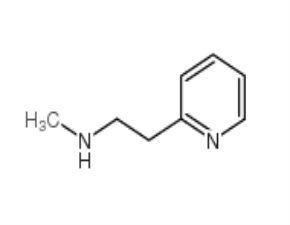
Betahistine
CAS No. 5638-76-6
Betahistine( —— )
Catalog No. M18815 CAS No. 5638-76-6
Betahistine is a histamine analog and H1 receptor agonist that serves as a vasodilator.
Purity : >98% (HPLC)
 COA
COA
 Datasheet
Datasheet
 HNMR
HNMR
 HPLC
HPLC
 MSDS
MSDS
 Handing Instructions
Handing Instructions
| Size | Price / USD | Stock | Quantity |
| 100MG | 38 | In Stock |


|
| 200MG | 46 | In Stock |


|
| 500MG | Get Quote | In Stock |


|
| 1G | Get Quote | In Stock |


|
Biological Information
-
Product NameBetahistine
-
NoteResearch use only, not for human use.
-
Brief DescriptionBetahistine is a histamine analog and H1 receptor agonist that serves as a vasodilator.
-
DescriptionBetahistine is a histamine analog and H1 receptor agonist that serves as a vasodilator. It is used in MENIERE DISEASE and in vascular headaches but may exacerbate bronchial asthma and peptic ulcers. Betahistine dihydrochloride is an anti-vertigo drug. It is commonly prescribed for balance disorders or to alleviate vertigo symptoms associated with Ménière's disease.(In Vitro):Betahistine (0-10 μM) inhibits [125I]iodoproxyfan binding to membranes of CHO (rH3(445)R) and CHO (hH3(445)R) cells with IC50 values of 1.9 μM and 3.3 μM, respectively. Lead to Ki values of 1.4 μM and 2.5 μM, respectively.Betahistine (0-10 μM) has a regulating function on cAMP formation in CHO (rH3(445)R), CHO (rH3(413)R), and CHO (hH3(445)R) cells. At low concentrations, betahistine behaves an apparent inverse agonist, and progressively enhances cAMP formation with EC50 values of 0.1 nM, 0.05 nM and 0.3 nM, respectively. In contrast, at concentrations higher than 10 nM, betahistine inhibits cAMP formation with an EC50 value of 0.1 μM in CHO (rH3(445)R) and full agonist activity. (In Vivo):Betahistine (intraperitoneal or oral administration; 0.1-30 mg/kg; single dose) with acute administration has increased tele-methylhistamine (t-MeHA) levels with an ED50 of 0.4 mg/kg, indicating the inverse agonism. Besides, after acute oral administration, it increases t-MeHA levels with an ED50 of 2 mg/kg in male Swissmice.Betahistine (oral adminstration; 1 and 5 mg/kg; daily for 3 weeks) attenuates the severity of arthritis and reduces the levels of pro-inflammatory cytokines in the paw tissues of CIA mice.
-
In VitroBetahistine (0-10 μM) inhibits [125I]iodoproxyfan binding to membranes of CHO (rH3(445)R) and CHO (hH3(445)R) cells with IC50 values of 1.9 μM and 3.3 μM, respectively. Lead to Ki values of 1.4 μM and 2.5 μM, respectively.Betahistine (0-10 μM) has a regulating function on cAMP formation in CHO (rH3(445)R), CHO (rH3(413)R), and CHO (hH3(445)R) cells. At low concentrations, betahistine behaves an apparent inverse agonist, and progressively enhances cAMP formation with EC50 values of 0.1 nM, 0.05 nM and 0.3 nM, respectively. In contrast, at concentrations higher than 10 nM, betahistine inhibits cAMP formation with an EC50 value of 0.1 μM in CHO (rH3(445)R) and full agonist activity.
-
In VivoBetahistine (intraperitoneal or oral administration; 0.1-30 mg/kg; single dose) with acute administration has increased tele-methylhistamine (t-MeHA) levels with an ED50 of 0.4 mg/kg, indicating the inverse agonism. Besides, after acute oral administration, it increases t-MeHA levels with an ED50 of 2 mg/kg in male Swissmice.Betahistine (oral adminstration; 1 and 5 mg/kg; daily for 3 weeks) attenuates the severity of arthritis and reduces the levels of pro-inflammatory cytokines in the paw tissues of CIA mice. Animal Model:Collagen-induced arthritis (CIA) DBA/1 male mouse model Dosage:1 mg/kg; 5mg/kg Administration:Oral adminstration; day 21 to day 42 after a 21-day CIA induction Result:Ameliorated mouse CIA by decreasing joint destruction.
-
Synonyms——
-
PathwayOthers
-
TargetOther Targets
-
RecptorH1 receptor
-
Research Area——
-
Indication——
Chemical Information
-
CAS Number5638-76-6
-
Formula Weight136.19
-
Molecular FormulaC8H12N2
-
Purity>98% (HPLC)
-
SolubilityIn Vitro:?DMSO : 100 mg/mL (734.27 mM)
-
SMILESCNCCc1ncccc1
-
Chemical Name——
Shipping & Storage Information
-
Storage(-20℃)
-
ShippingWith Ice Pack
-
Stability≥ 2 years
Reference
1.Albu S,et al . Treatment of Meniere's disease with intratympanic dexamethazone plus high dosage of betahistine. Am J Otolaryngol. 2016 May-Jun;37(3):225-30.
molnova catalog



related products
-
Teriparatide acetate
Teriparatide (Human parathyroid hormone-(1-34)) is a PHT agonist, with an IC50 of 2 nM in HEK293 cells.Teriparatide is a recombinant form of parathyroid hormone.?
-
GW6340
GW6340 is a selective LXR agonist with potential anticancer activity that promotes macrophage reverse cholesterol transport (mRCT) and can be used to study atherosclerosis.
-
trans-Urocanic Acid
trans-Urocanic Acid ((E)-Urocanic acid), a compound predominantly distributed in the hippocampus and prefrontal cortex, is an isomer of cis-UCA, an epidermal UV-protectant, which enhances the stability of tenofovir eplerenomide in long-acting HIV applications.



 Cart
Cart
 sales@molnova.com
sales@molnova.com


